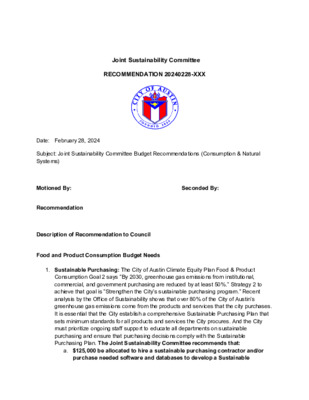2024-02-28 JSC Consumption Natural Systems Budget Recommendations_ — original pdf
Backup

Joint Sustainability Committee RECOMMENDATION 20240228-XXX Date: February 28, 2024 Subject: Joint Sustainability Committee Budget Recommendations (Consumption & Natural Systems) Motioned By: Seconded By: Recommendation Description of Recommendation to Council Food and Product Consumption Budget Needs 1. Sustainable Purchasing: The City of Austin Climate Equity Plan Food & Product Consumption Goal 2 says “By 2030, greenhouse gas emissions from institutional, commercial, and government purchasing are reduced by at least 50%.“ Strategy 2 to achieve that goal is “Strengthen the City’s sustainable purchasing program.” Recent analysis by the Office of Sustainability shows that over 80% of the City of Austin’s greenhouse gas emissions come from the products and services that the city purchases. It is essential that the City establish a comprehensive Sustainable Purchasing Plan that sets minimum standards for all products and services the City procures. And the City must prioritize ongoing staff support to educate all departments on sustainable purchasing and ensure that purchasing decisions comply with the Sustainable Purchasing Plan. The Joint Sustainability Committee recommends that: a. $125,000 be allocated to hire a sustainable purchasing contractor and/or purchase needed software and databases to develop a Sustainable Purchasing Plan that sets minimum standards for all products, materials and services purchased by the city; and b. A full-time Sustainable Purchasing Director position should be added to the Purchasing Department. If an FTE is determined to be infeasible in this budget cycle, a temporary Sustainable Purchasing Director position should be established and funded. Natural Systems Budget Needs 2. Converting Impervious Cover to Functional Green: The City of Austin Climate Equity Plan Natural Systems Goal 4 says “By 2030, include all City-owned lands under a management plan that results in neutral or negative carbon emissions and maximizes community co-benefits.” Strategy 2 to achieve this goal is “Reclaim public space and prioritize green infrastructure.” There is no inventory of the unnecessary impervious cover on City-owned lands, or a plan for converting those areas to functional green. Areas along city streets, in and around parking lots, at city buildings, and in city parks all need evaluation and a plan to remediate. The Joint Sustainability Committee recommends that $200,000 be allocated to audit City-owned non-functional or unnecessary impervious cover, including surface-level parking lots, and develop a plan to convert an ambitious percentage of these to functional green uses as soon as practical. 3. No Mow Signage: The City of Austin Climate Equity Plan Natural Systems Goal 4 says “By 2030, include all City-owned lands under a management plan that results in neutral or negative carbon emissions and maximizes community co-benefits.” Strategy 1 to achieve that goal says “Prioritize carbon neutrality for public lands.” While Watershed Protection supports the Wildflower Meadow initiative and Grow Zone program, there is a need to educate communities to build support for these since areas mowed less frequently or not mowed are sometimes perceived as abandoned or not cared for. The Joint Sustainability Committee recommends that $75,000 be allocated for permanent signage to show city land is not being neglected but rather managed for wildlife. Signage should be prioritized in low income and BIPOC neighborhoods, be bilingual and include visuals such as the example below. 4. Carbon-Neutral Public Lands: The City of Austin Climate Equity Plan Natural Systems Goal 4 says “By 2030, include all City-owned lands under a management plan that results in neutral or negative carbon emissions and maximizes community co-benefits.” Strategy 1 to achieve that goal says “Prioritize carbon neutrality for public lands.” However, there are significant challenges with implementing this strategy including: a. Parks and Recreation are missing functioning automated irrigation systems and lack staffing to hand water, which leads to inefficient and inadequate watering and the need to replace dead trees b. Horticulture has unfunded mandates for maintaining existing installations and areas like rain gardens c. Land Management has been turning down foundation funding and has budget savings due to inadequate staff to plan projects, initiate contracts and steward the funding The Joint Sustainability Committee recommends that: ● $250,000 be allocated for installation of efficient automated/drip irrigation on Parks and Recreation property with native trees and landscaping, with priority near underserved communities with lower access to nature in East Austin ● $150,000 in additional annual funding be allocated for maintenance of existing installations and irrigation systems ● A full-time Program Manager position be created and funded to plan City land management projects and identify and apply for funding to implement them.